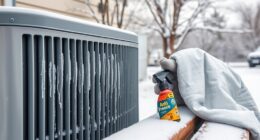To keep your heat pump running smoothly, follow seasonal checklists like inspecting and cleaning filters, clearing debris from the outdoor unit, checking airflow, and ensuring proper insulation during colder months. In summer, replace filters and schedule professional tune-ups for ideal cooling. Regularly monitor for unusual noises or issues and address them promptly. Staying on top of these tasks helps prevent breakdowns and extends your system’s life; discover more tips to maintain efficiency year-round.
Key Takeaways
- Inspect and clean filters monthly during peak seasons to ensure optimal airflow and efficiency.
- Clear debris and obstructions from outdoor units to prevent overheating and promote proper operation.
- Check and seal insulation around the heat pump to minimize heat loss in winter and improve performance.
- Schedule professional tune-ups before heavy usage periods to maintain system reliability and efficiency.
- Monitor for unusual noises, smells, or performance issues and address them promptly to avoid costly repairs.

Maintaining your heat pump throughout the year guarantees it runs efficiently and lasts longer. Regular upkeep is essential, especially as seasons change, to keep your system functioning at its best. One of the most important aspects of this maintenance is verifying your furnace components are in good shape, even if your heat pump is the primary heating source. Furnace maintenance involves inspecting and cleaning filters, checking vents for obstructions, and ensuring the blower operates smoothly. When these parts are in top condition, your heat pump can transfer heat more effectively, boosting energy efficiency and reducing your utility bills. Neglecting this maintenance can lead to increased energy consumption and unnecessary wear on your system, ultimately shortening its lifespan.
Regular furnace maintenance enhances heat pump efficiency and extends system lifespan.
As you shift between seasons, take time to clear debris from around your outdoor unit. Leaves, dirt, and other obstructions can hinder airflow, forcing the system to work harder and consume more energy. A clean, unobstructed unit not only improves energy efficiency but also prevents overheating and damage. Regularly inspecting the condensate drain and clearing away any blockages helps prevent water damage and mold growth inside your system. During colder months, ensure your heat pump is properly insulated and that your thermostat settings are optimized for efficiency. Proper insulation minimizes heat loss, making your system’s job easier and more cost-effective. Incorporating vertical storage solutions can also help keep the area around your unit organized and accessible for maintenance.
In the warmer months, focus on maintaining good airflow and cleanliness. Replace or clean filters monthly, especially during peak usage periods, to keep dust and allergens out of your home and to support your system’s efficiency. An efficient heat pump consumes less energy, saving you money and reducing environmental impact. Additionally, schedule a professional tune-up before heavy usage begins. A technician can perform a thorough furnace maintenance check, including inspecting electrical connections, refrigerant levels, and overall system performance. These checks ensure your heat pump operates at peak efficiency, providing reliable cooling during hot days.
Throughout the year, pay attention to unusual noises, strange smells, or inconsistent heating and cooling. Addressing minor issues early prevents them from becoming costly repairs later. Keeping your heat pump well-maintained isn’t just about comfort; it’s a wise way to maximize energy efficiency, save on bills, and extend the lifespan of your system. By following seasonal checklists and staying proactive with furnace maintenance, you ensure your heat pump remains dependable, efficient, and ready to serve your home year-round.
Frequently Asked Questions
How Often Should I Replace My Heat Pump Filters?
You should replace your heat pump filters every 1 to 3 months, depending on the air filter lifespan and your home’s air quality. During peak allergy seasons or if you have pets, consider more frequent replacements. Following a consistent filter replacement schedule helps your heat pump run efficiently and maintains good indoor air quality. Always check the manufacturer’s recommendations for your specific filter type to guarantee peak performance.
Can I Perform Heat Pump Maintenance Myself?
You can definitely perform some heat pump maintenance yourself—an ounce of prevention is worth a pound of cure. Start with simple DIY tips like cleaning filters, inspecting ducts, and clearing debris. However, for more complex tasks like refrigerant checks or electrical work, it’s best to call professional services. Knowing your limits guarantees safety and efficiency, saving you money and extending your heat pump’s lifespan.
What Signs Indicate My Heat Pump Needs Repairs?
If your heat pump shows signs like inconsistent heating, strange noises, or frequent cycling, it’s time for heat pump troubleshooting. You might notice higher energy bills or a failure to heat your space properly. These issues often indicate repairs are needed, and repair cost estimates can vary. Address problems early to avoid costly damage, and consider consulting a professional for accurate diagnosis and affordable repairs.
How Does Climate Affect Heat Pump Longevity?
Climate impact plays a significant role in your heat pump’s longevity. Harsh winters or hot, humid summers can strain the system, leading to faster wear and tear. Factors like frequent temperature fluctuations, exposure to salt or pollution, and moisture levels also affect longevity. To maximize your heat pump’s lifespan, guarantee regular maintenance, protect it from extreme weather, and address issues promptly, regardless of your climate.
Are There Eco-Friendly Options for Heat Pump Maintenance?
Yes, you can choose eco-friendly refrigerants and sustainable maintenance options for your heat pump. Opting for eco-friendly refrigerants diminishes environmental impact, while sustainable maintenance practices like regular filter changes and using energy-efficient parts help prolong your system’s life. These choices support environmental health and ensure your heat pump runs efficiently, saving you money in the long run. Always consult with professionals about eco-conscious upgrades to maximize your system’s sustainability.
Conclusion
Think of your heat pump as the heartbeat of your home, quietly working behind the scenes. By following these seasonal checklists, you’re nurturing it like a garden in full bloom—each task a gentle rain or warm sun that keeps it thriving. When you care for it regularly, your heat pump continues to serve as a loyal guardian, ensuring comfort all year round. Keep tending to it, and it’ll keep your home cozy no matter the season.








